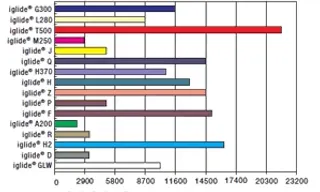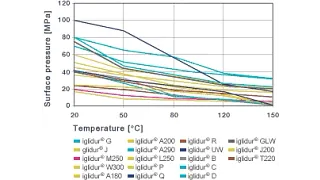Change Language :
iglide® Plastic Bushings: Surface Pressure & Load
Surface Pressure
The load a plastic bushing can withstand is defined in terms of surface pressure (psi). For this reason, the permissible radial load is determined by the projected surface area of the plastic bushing.
- Radial bushing: p = F/(d1 x b1)
For axial bushings, the load is produced accordingly.
- Axial bushing: p = F/(d22 - d12) x π/4
In this process:

F
Load (lbs)
d1
Inner diameter of the plastic bushing (inches)
b1
Plastic bushing length (inches)
d2
Outer diameter of the plastic bushing (inches)
Maximum Recommended Surface Pressure

A comparative value of the iglide® plastic bushing material is the permissible static surface pressure (p) at 68°F. The values of each individual iglide® plastic bushing differ when it comes to this.
The value (p) indicates maximum load of a plastic bushing. The plastic bushing can continuously tolerate this load without any damage occurring. The given value applies to static operation; only very slow speeds up to 1.97 fpm are tolerated under this load. Higher loads than those indicated are possible if the load is only applied for a short period. For a few minutes, the load can be more than doubled, depending on the material. Please contact us if you have any questions.
Bearing Loads
Additional Technical Information
Contact Us
Questions or product information? Please contact:

Customer Service
Customer Service:
Phone: Monday to Friday from 8 am - 8 pm
LiveChat: 24 hours
Book a Call
Book an Appointment with a Product Expert



